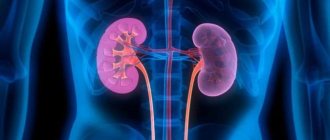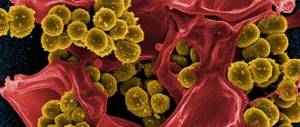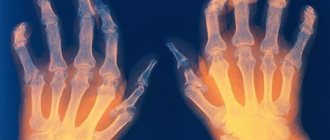Classification and stages of development of kidney tuberculosis
First of all, it is worth mentioning the classification of urogenital tuberculosis, which affects the organs of the genitourinary system, both isolated and in any combination [2] [3] [4] [6] [7].
The clinical classification of renal tuberculosis is directly related to the anatomical and functional changes in the organ [3; 4; 6; 7].
Based on the presence of bacilli or excretion of mycobacteria (MBT) in the urine, the disease is divided into:
- nephrotuberculosis with bacterial excretion - designated “MBT (+)”;
- nephrotuberculosis without bacterial excretion - designated “MBT (-)” [7].
Below is the classification of kidney tuberculosis, which is used in practical medicine. It is based on the severity of destructive processes occurring in the kidneys [7].
| Stages of the disease | Characteristics of the pathological process |
According to the affected side, kidney tuberculosis is divided into unilateral and bilateral. According to the prevalence, it is customary to distinguish between tuberculosis with damage to one calyx, total damage to the kidney and damage to a single kidney [7].
Differential diagnosis of renal tuberculosis
Differential diagnosis of renal tuberculosis should be carried out with hydronephrosis, ureterohydronephrosis, pyelonephritis, especially with the outcome in pyonephrosis and the presence of purulent fistulas in the lumbar region. Radiological signs of the process must be distinguished from medullary necrosis, which complicates the course of purulent pyelonephritis, anomalies of the medullary substance (spongy kidney, calyx diverticulum, megacalyx, megakaliosis). Disabled destructive foci in tuberculosis can be similar to cystic and dense tumor-like formations in the parenchyma, deforming the contours of the kidney and pyelocaliceal system. The leading criterion should be a combination of clinical, laboratory, ultrasound, radiological and other data. Persistent dysuria and pyuria should be an indication to exclude banal chronic inflammation using laboratory tests of urine in two (in men, three, with examination of prostate secretions) portions and bacteriological studies, as well as urethrocystoscopy and endovesical biopsy.
[12], [13], [14], [15], [16], [17], [18], [19], [20], [21], [22]
Diagnosis of nephrotuberculosis
Since the disease may not manifest itself with clinical symptoms at the initial stage, instrumental studies and laboratory tests are crucial. Pathology can be suspected on the basis of previous extrarenal tuberculosis or prolonged contact with a tuberculosis patient. In this case, the patient must be sent for consultation to a phthisiatrician and undergo a tuberculin test.
The tuberculin test has diagnostic value in cases of suspected tuberculosis infection
The urologist identifies a pronounced Pasternatsky symptom - sharp pain when tapping in the area of the affected kidney. In thin patients, you can palpate an enlarged, dense kidney with an uneven surface.
Laboratory research
Of the laboratory tests, the following are of primary importance in making a diagnosis:
- Clinical urine analysis. It is characterized by a sharply acidic environment, a high content of leukocytes, protein, and erythrocytes.
- Urine culture. Mycobacteria are found in it.
- Clinical blood test. Most often it shows low hemoglobin and high leukocytosis, which indicates an infectious process in the body.
- PCR blood test. Diagnostics based on identifying DNA sections of tuberculosis pathogens.
- ELISA (enzyme-linked immunosorbent assay). Detects immunoglobulins (antibodies) to Koch bacilli antigens.
A positive urine test for Mycobacterium tuberculosis is decisive in making a diagnosis.
In some cases, provocative tuberculin tests are used, which involve subcutaneous injection of tuberculin, after which the patient experiences an exacerbation of the disease, which is manifested by active mycobacteriuria (the presence of bacilli in the urine), increased protein content in the urine and severe pyuria (pus in the urine).
Instrumental methods
Instrumental studies help in making a diagnosis:
- Ultrasound makes it possible to assess the degree of kidney damage and identify cavities and tuberculomas.
- X-ray examination (excretory or survey urography, retrograde urethropyelography) - allows you to determine the condition of the collecting apparatus, renal parenchyma and urinary tract.
- Radioisotope nephroscintigraphy. It consists of introducing a radioactive drug into the patient’s body and visualizing the kidneys using a gamma camera. Provides information about the functionality of the affected organ.
- Magnetic resonance and computed tomography. They provide extensive data on the condition and extent of kidney damage - foci of destruction, their isolation or communication with vessels, calyces and pelvis, as well as the participation of nearby lymph nodes in the pathological process.
- Angiography is an X-ray examination of the kidney vessels. Helps to study the functional state of blood vessels and the extent of the affected area.
One of the important methods for diagnosing nephrotuberculosis is MRI.
Differential diagnosis
Nephrotuberculosis is differentiated with the following pathologies:
- pyelonephritis;
- hydronephrosis;
- calyx diverticulum;
- spongy bud;
- polycystic disease;
- megacalyx (a developmental anomaly characterized by the expansion of some calyxes);
- kidney neoplasm.
Diagnostic measures
To detect the disease, the following diagnostic procedures are performed:
- general urine analysis. When it is carried out, a sediment containing mycobacteria is detected;
- cystoscopy. This diagnostic procedure involves examining the parenchyma for the presence of neoplasms filled with fluids. When performing cystoscopy, a special contrast agent is used;
- X-ray. A diagnostic measure allows you to get an accurate result. Foci of tuberculosis are visually different from kidney stones and other pathologies.
Forecast. Prevention
Despite the effectiveness of modern chemotherapy, genitourinary tuberculosis remains a serious threat to the patient's life if it is not diagnosed in time and treated properly. Late presentation reduces the possibility of treating tuberculosis to zero.
Urogenital tuberculosis usually develops 5-46 years after recovery from respiratory tuberculosis, on average this period takes 22 years. Migrants and elderly people, as well as those who have received immunotherapy for muscle-invasive bladder cancer with the BCG vaccine, are at increased risk.
With tuberculous lesions of the kidney parenchyma and tuberculous papillitis, the prognosis is favorable. Cavernous tuberculosis of the kidney also resolves safely - the cavity is transformed into a sanitized cyst, and post-tuberculosis deformation of the pyelocaliceal system is formed.
An unfavorable outcome is the progression of destructive changes with the appearance of a large number of cavities and the development of tuberculosis of the urinary tract. Polycavernous tuberculosis of the kidney can usually be cured only by removing the organ.
The emergence of multidrug-resistant mycobacteria that cannot be suppressed and destroyed by modern drugs, the active and round-the-clock exchange of infection in medical institutions and sanatoriums does not provide protection against superinfection - a sharp growth of another type of bacteria. The problems are compounded by a narrowing choice of medications. And if a person is in a group of mycobacteria excretors, then no long-term treatment measures or regimens for the use of antimicrobial drugs will ensure his cure [3] [4] [6] [7] [13].
Kidney tuberculosis: symptoms and treatment, contagious or not
Kidney tuberculosis (nephrotuberculosis) is an infectious lesion of the kidney tissue caused by Koch's bacillus. It manifests itself with nonspecific symptoms 2-3 years after infection.
Patients complain of urinary disorders, pain in the lumbar region, blood in the urine, fever and malaise. For diagnosis, nephroscintigraphy, urine and blood tests, and x-rays are performed.
Treatment is carried out with medication or surgery.
Features and reasons
Kidney tuberculosis is an extrapulmonary infectious pathology caused by Mycobacterium tuberculosis (MBT). Detected in 30% of urological patients.
Infection of the outer layer leads to the destruction of functional tissue (parenchyma), resulting in the appearance of cavities - cavities with liquid contents.
With delayed treatment, purulent melting of the affected areas is revealed - tuberculous pyonephrosis.
To find out how the infection is transmitted, it is necessary to consider the characteristics of the pathogen. Unlike many other microorganisms, mycobacteria do not release toxic substances. Therefore, immediately after infection, external symptoms do not appear.
Nephrotuberculosis occurs as a complication of bone or pulmonary tuberculosis 3-10 years after infection.
Renal tuberculosis is diagnosed equally often in women and men. For a long period it is asymptomatic, so it often causes serious complications.
You can get an infection from a sick person. MBT penetrates the kidney hematogenously - through the bloodstream. People suffering from urological diseases are susceptible to infection of the renal parenchyma:
- nephrolithiasis;
- chronic pyelonephritis;
- pyelitis;
- glomerulonephritis;
- hydronephrosis.
With the blood flow, MBT penetrates into the glomerular apparatus, where it forms many small tuberculous foci. During normal functioning of the immune system, they are resolved. In case of decreased immunity, other parts of the kidneys are involved in inflammation - the medulla, tubules. Due to damage to the apexes of the pyramids (papillae), tuberculous papillitis occurs.
If left untreated, Mycobacterium tuberculosis penetrates into:
- renal pyramids;
- calyxes;
- pelvis.
Factors provoking tuberculous kidney damage:
- colds;
- stones in the kidneys;
- alcohol abuse;
- endocrine disorders;
- hypothermia;
- operations on the pelvic organs;
- vitamin and mineral deficiency.
Without proper therapy, pathological cavities - cavities - form in the parenchyma. With the flow of urine, the infection penetrates into other parts of the urinary system - ureters, urethra, bladder, etc.
In a quarter of cases, the reason for nephrectomy—removal of the kidney—is nephrotuberculosis.
Symptoms of kidney tuberculosis
In the initial stages, tuberculosis is asymptomatic. The first signs appear when kidney function is impaired 2 years after infection:
- decreased performance;
- fast fatiguability;
- causeless loss of body weight;
- moderate increase in temperature.
As a result of erosive damage to blood vessels and parenchyma in adults, the following appear:
- arterial hypertension;
- hematuria (blood in urine);
- pus in the urine;
- frequent urge to go to the toilet;
- decrease in daytime diuresis.
With cavernous tuberculosis in women and men, symptoms of intoxication come to the fore.
There is moderate pain in the lower back.
With scarring of the calyxes and disruption of the outflow of urine into the bladder, the symptoms are replenished:
- sharp pain in the lower back;
- renal colic;
- painful urination.
Kidney tuberculosis in children is diagnosed extremely rarely. It progresses rapidly until the age of 8-10 years. If the urea is involved in inflammation, the following are noted:
- pain in the suprapubic area;
- red urine;
- urge to go to the toilet at night;
- urgency to go to the toilet;
- cloudy urine.
As a result of spasm of the muscular layer of the bladder, urination becomes difficult. As the bladder fills with urine, pelvic pain intensifies.
Diagnostic methods
Instrumental and laboratory tests are of key importance in the diagnosis of nephrotuberculosis. During the initial examination, the doctor palpates the lumbar region.
In thin people, kidneys with a lumpy surface can be felt, and the pain intensifies.
Diagnosis of kidney tuberculosis:
- Clinical blood test. Inflammation is indicated by an increase in the level of leukocytes and a decrease in hemoglobin concentration.
- General urine analysis. The pH of urine shifts to the acidic side. It contains leukocytes, proteins and red blood cells.
- PCR diagnostics. During urine testing, the structure of the genetic material of the pathogen is determined.
- Urine culture. Using light filters, growing mycobacteria are detected in urine.
- Ultrasound of the kidneys. Echo signs are used to determine the heterogeneity of the surface of the parenchyma, cavities, areas of calcification, scarring of the calyces or pelvis.
- Renal angiography. The degree of damage to the hepatic vessels and possible methods of performing the operation are assessed.
In doubtful cases, they resort to tuberculosis diagnostics - they do provocative tests using tuberculin. Patients with tuberculosis experience allergic reactions, and the concentration of red and white blood cells in urine increases.
According to complex diagnostics, a nephrologist or urologist distinguishes nephrotuberculosis from polycystic disease, hydronephrosis, spongy kidney, and pyelonephritis.
Prognosis for recovery
The effectiveness of treatment depends on many factors - the stage of tuberculosis, age, and the presence of concomitant urological pathologies. Recovery occurs in the case of adequate therapy and in the absence of serious changes in the ureters, bladder, renal tubules, calyces and pelvis.
The prognosis worsens with bilateral kidney damage with obvious signs of parenchymal calcification.
Dangerous consequences of infection
Mycobacterium tuberculosis penetrates other organs through blood, urine and lymph. With delayed treatment, the infection from the kidneys penetrates into the appendages of the sex glands, ovaries, testicles, fallopian tubes, and uterus.
Possible complications of tuberculosis:
- orchitis;
- endometritis;
- genital tuberculosis;
- oophoritis;
- renal amyloidosis;
- prostatitis;
- colpitis;
- epididymitis;
- tuberculous pyonephrosis;
- calcification of the kidney.
Children's bodies are less resistant to infections, which increases the risk of chronic kidney failure. The disease cannot be treated effectively, so patients are forced to undergo dialysis, a procedure for mechanically purifying the blood of metabolic products, up to 3 times a week throughout their lives.
Relevance of the issue
Among all forms of tuberculosis localized outside the lungs, the renal variant is the most common. As a rule, the disease is secondary, appearing against the background of damage to the respiratory or musculoskeletal system. Tuberculosis is one of the most common diseases. It is no secret that various forms of infection can be transmitted through aerosols and even by touching an object used by the patient. Blood flow and lymph flow allow pathological microflora to penetrate the kidneys. In this organ, blood moves through the vessels rather slowly, as the fluid is filtered. In addition, there are many vessels themselves. All this creates a convenient environment for the proliferation of mycobacteria; the likelihood of developing an infectious focus is significantly higher than in other organs.
Tuberculosis develops in representatives of different age groups and different genders. Up to 2% of patients are children under ten years of age, one patient out of ten is a patient under twenty years of age. There are isolated cases of renal tuberculosis in infants. In childhood, the kidneys and respiratory system or bones and kidneys most often suffer due to infection with pathological microflora.
Causes of development and pathogenesis
The main route of infection is hematogenous, that is, the pathogen is transferred through the blood to the urinary system, causing a specific inflammatory process. It is important to understand that renal tuberculosis occurs secondary, that is, after the preliminary occurrence of a pathological focus in the lungs. There is clinical evidence that in rare cases, pathology can occur after alimentary (through the digestive tract) infection.
Kidney tuberculosis appears due to some anatomical features of these organs:
- well-developed microvasculature in all areas;
- slow blood flow in the filtration system;
- excellent contact between blood vessels and interstitium (intermediate tissue).
The above features contribute to the appearance of primary foci of infection in all areas of the kidney, especially in the superficial tissues.
Pathological processes can lead to the following disorders:
- reversible development of the inflammatory process without any external changes;
- the appearance of scar tissue at the site of inflammatory foci;
- the appearance of areas of necrosis with the formation of cavities (tuberculosis cavities).
It is important to note that the main reason for the development of tuberculosis in the urinary tract is insufficient immune reactivity of the body. That is, in most cases, kidney tuberculosis is transmitted to people who suffer from immunodeficiency (AIDS, HIV, hepatitis, cancer, drug addiction and alcoholism). Such a person becomes doubly contagious, since the depleted immune system is unable to contain the mycobacterium.
Infection of the urinary tract is a secondary process and occurs as a result of infection through urine or lymph. In this case, damage to the genital organs may also occur. This is especially pronounced in men; according to statistics, this process is observed in more than half of patients.
Favorable conditions for the development of tuberculosis occur in patients with concomitant inflammatory pathologies of the urinary system.
How to notice?
The first signs of kidney tuberculosis are divided into local and general. A person often feels tired, and the temperature often rises above normal. I'm worried about high blood pressure. Studies show gross hematuria, increased erythrocyte sedimentation rate. When studying the renal parenchyma, foci of destructive processes and pus discharge can be detected.
Local symptoms of renal tuberculosis in adults (and children) include lower back pain. Analyzes show pyelonephritis, study of the kidney parenchyma gives an idea of destructive processes.
Tuberculosis of the kidneys and urinary tract * Diana Clinic in St. Petersburg
The causative agent of tuberculosis is the microorganism Mycobacterium tuberculosis or Koch's bacillus. Transmitted by airborne droplets. The primary site of the disease is usually in the lungs. Tuberculosis of the kidneys and urinary tract is a secondary disease - a consequence of the spread of bacteria through the circulatory and lymphatic systems into the renal cortex.
What it is?
Tuberculosis of the kidneys and urinary tract is one of the most common types of extrapulmonary type of this disease. Mycobacteria penetrate the kidneys hematogenously from a hidden source of infection, so diagnosis is often made at later stages.
The first signs appear in the cortical layer of the organ - these are characteristic tubercles. Often only one of the two is affected, much less often both. Later, the process begins to develop rapidly, involving the ureters and bladder.
Causes
There are several reasons why tuberculosis can occur:
- contact with a person suffering from an open form of pulmonary tuberculosis;
- unfavorable living conditions;
- weakened immunity;
- advanced form of pulmonary type;
- consumption of contaminated cow's milk and cattle meat.
Several factors contribute to a decrease in the body’s defense reactions and the development of the disease:
- tobacco smoking, alcoholism, drug addiction;
- hazardous production;
- frequent diseases of the respiratory system;
- diabetes;
- nutritional disorders, lack of vitamins, microelements;
- depressive, neurotic conditions;
- pregnancy;
- hypothermia;
- endocrine diseases;
- unfavorable social and living conditions.
When asked whether kidney tuberculosis is contagious or not, doctors answer in the affirmative. How is the infection transmitted? There are several methods of transmission of infection: airborne, contact-household, hemato-lymphogenous, urogenic.
Classification
Tuberculosis of the kidneys and urinary tract is classified into stages depending on the degree of development and manifestations of the disease:
- Parenchymal tuberculosis
. The initial form without organ destruction, the prognosis for cure is favorable. - Tuberculous papillitis.
It can be either one-sided or two-sided. It is characterized by the formation of single cavities or small papillitis, no more than one centimeter. Conservative treatment offers a good chance of cure. - Cavernous.
Damage to one of the kidney segments, characterized by the formation of a subcortical cavity. Clinical manifestations are similar to carbuncle. Usually requires surgery. - Polycavernous.
The presence of several cavities that affect almost the entire organ. Purulent melting with the formation of a fistula, pyonephrosis occurs. Filling of the caverns with calcium salts leads to fusion of the pelvis and ureters, and shrinkage of the kidney.
Complications
- Chronic renal failure
due to the death of nephrons. - Amylodoise.
Deposition of insoluble protein in the kidney tissue, leading to disruption of basic functions. - Rejuvenation.
Areas affected by calcium salts form tuberculomas, which begin to cause a complete cessation of fluid outflow. Treatment is only surgical with removal of the affected organ. - Atrophy
.Tissue death followed by degeneration into fibrous tissue with loss of organ functions.
Symptoms and stages
Tuberculosis of the urinary tract is characterized by the absence of specific symptoms, which complicates the diagnosis of the disease. Clinical manifestations depend on the level of damage and the individual characteristics of the patient.
Often, at the primary stage, the disease manifests itself asymptomatically or is hidden under the clinical picture of pyelonephritis or urolithiasis.
Primary symptoms in the initial stages:
- general weakness;
- fast fatiguability;
- low-grade fever;
- constant surges in blood pressure;
- constant dull pain in the lumbar region, lower abdomen;
- frequent urination;
As the disease progresses, more serious signs are added:
- decrease in the volume of urine excreted;
- enuresis;
- pain when urinating;
- signs of intoxication;
- the appearance of blood and pus in the urine.
- a sharp decrease in the patient’s weight;
Kidney tuberculosis in children
Previously, the disease mostly affected the adult part of the population, but recently it is more often diagnosed in children. This is directly related to the environment - environmental pollution, unfavorable living conditions, nutritional disorders.
The peculiarity of the extrapulmonary type is that it may not appear for many years. And with reduced immunity, on the contrary, it will accelerate, but may appear in the form of other diagnoses. This leads to late detection of the disease and advanced forms of the disease.
Loss of weight and appetite, pale skin, frequent urination, nocturnal enuresis, and cloudy urine should alert parents. You need to see a doctor and get tests done.
Renal tuberculosis in adults
There are several features in the manifestation of the disease in adults:
- tuberculosis can be both secondary and primary (that is, mycobacteria enters the bloodstream immediately);
- women suffer less from the renal type of this disease than men;
- the age range of those affected ranges from 20 to 45 years;
- in men, the disease process almost always involves the organs of the reproductive system (prostate, testicles);
- a small percentage of sick women who became infected with mycobacteria from procedures performed in beauty salons;
In pregnant women
If a specialist diagnoses nephrotuberculosis in a woman while she is pregnant, one of the recommendations will be to terminate the pregnancy.
There are several factors that explain this:
- since the circulatory systems of the kidneys and uterus are closely located, the risk of intrauterine infection in the fetus is very high;
- treatment with medications will negatively affect the development of the fetus;
- Pregnancy is a special condition of a woman; it can aggravate chronic diseases and abnormal processes in the body.
But such a decision will be made only by a council of doctors and with the consent of the woman herself. If a decision is made to continue the pregnancy, medications are prescribed and the patient is constantly monitored by a phthisiologist, in addition to an obstetrician-gynecologist, throughout the entire period.
A newborn must undergo a tuberculin test. If the result is negative, the baby is vaccinated with BCG.
Diagnostics
Due to the hidden, long incubation period of urinary tract tuberculosis, it is often very difficult to detect in the early stages. But the sooner the mycobacterium and the affected area are identified, the more effective the treatment will be and the prognosis will be more favorable.
Therefore, when complaining of lower back pain, weakness and malaise, the doctor must carry out:
- collect anamnesis - find out about any contacts of the patient with patients with this disease, whether there was such a diagnosis previously in the family, whether there were any animal bites;
- examination and palpation (an enlarged kidney can only be felt in thin people);
- analyze all symptoms;
- order laboratory tests.
To make a correct diagnosis, laboratory tests are necessary:
To determine the exact size of the lesions and affected areas, an additional computed tomography or magnetic resonance imaging is prescribed. Also, the latest modern methods make it possible to determine the localization of lesions, the stage of the disease and the functionality of the organ:
- angiography – gives a complete picture of the renal vascular system;
- excretory urography - an x-ray with a contrast agent will help evaluate the entire functioning of the urinary system;
- nephroscintigraphy - the introduction of radioisotopes and tracking through a gamma camera provides a complete picture of the functionality of the renal structures.
Treatment of tuberculosis of the kidneys and urinary tract
The choice of treatment depends on gender, age, general medical history and the degree of organ damage. Conservative treatment is aimed at stopping the development of pathogenic microflora, preventing further damage to kidney tissue, and reducing the intensity of symptoms.
It is carried out only in a specialized medical institution. The treatment period for this disease is long, from 6 to 36 months, depending on the stage of the lesion.
Drug treatment
The drug treatment regimen consists of several types of effects on the body:
- anti-tuberculosis drugs (Isoniazid, Rifampicin, Ethambutol, Pyrazinamide);
- angioprotectors to reduce vascular permeability (Detralex, Aescusan);
- antibiotics from the aminoglycoside group (Streptomycin, Kanamycin, Neomycin);
- drugs to enhance immunity (Ribomunil, Imudon);
- non-steroidal anti-inflammatory drugs (Ibuprofen, Ketofen).
- vitamins.
The regimen for taking anti-tuberculosis drugs depends on the type:
- main (first row) – highly effective and low toxic.
- reserve (second row) - ineffective, but highly toxic.
Reserve drugs are prescribed when the patient has an individual intolerance to main-line drugs. Or when the pathogen is highly resistant to chemotherapy.
At the initial stage, you need to use injections, later you can take medications in tablets.
Surgery
If the outflow of urine is impaired, a catheter or drainage is installed. If nephrostomy does not help and the damage process leads to irreversible destructive consequences, then the question arises of surgery to remove the organ.
Before and after the scheduled operation, anti-tuberculosis therapy must be carried out for a month to delay the development of infection and protect a healthy kidney. The operation is partial (with the removal of one segment or cavity) or radical (complete removal of the organ).
ethnoscience
Naturally, with such a disease, the use of traditional medicine should in no case replace the main treatment, but only increase the effectiveness of the therapy. There are many folk recipes that help with tuberculosis of the urinary system.
For example:
- Prepare a mixture of dry components of bean leaves, black currant leaves, birch buds, yarrow in equal proportions. Pour two tablespoons of the prepared mixture into half a liter of cold water, bring to a boil, then simmer over low heat for 5 minutes. Then let it sit for 2 hours. Then filter the broth and take one tablespoon three times a day 20 minutes before meals;
- Propolis oil. Take 100 grams of propolis, freeze it in the freezer, then grate it. Melt 500 grams of butter in a steam bath. When it melts, add propolis to it. Stirring with a wooden spatula over low heat, without letting it boil, the mixture will be ready in an hour and a half. Then remove from heat and stir until completely thickened. Store the finished propolis oil in the refrigerator. Consume one dessert spoon twice a day, regardless of meals;
- 10% mummy solution. Take 20 tablespoons of boiled water, add 10 grams of mumiyo to it, stir until completely dissolved. Take one tablespoon every day in the morning an hour before meals and after dinner 3 hours later.
Prevention
The main preventive measure for nephrotuberculosis of the kidneys is the early detection of Koch bacilli in the body. To do this, it is necessary to undergo an annual examination by a urologist, conduct a bacteriological examination of urine in case of difficulty urinating, or pain in the lower back. Undergo fluorographic examination of the lungs for early diagnosis of the pulmonary form.
An important factor in prevention, especially in children, is timely vaccination and Mantoux tests. Also, do not forget that proper, nutritious nutrition is required, and protect yourself from hypothermia.
ONLINE REGISTRATION at the DIANA clinic You can make an appointment by calling the toll-free phone number 8-800-707-15-60 or filling out the contact form. In this case, we will contact you ourselves.
, please select a piece of text and press Ctrl+Enter
link:
Source: https://medcentr-diana-spb.ru/urologiya/tuberkulez-pochek-i-mochevyvodyashhih-putej/
Progress of the disease
Symptoms of kidney tuberculosis at an advanced stage usually indicate the need for treatment. The process is accompanied by complications, which is why the patient usually seeks medical help. Tuberculosis can provoke inflammation of the prostate, urethra, and appendages. Dysuretic disorders are possible, lower back pain becomes very severe, and blood fractions are observed in the urine. Such symptoms indicate the development of the disease.
Acute symptoms are extremely rare. With pathology, an increase in pressure and a general state of poisoning are possible. When renal tuberculosis spreads to the upper regions of the ureter, the bladder, dysuretic failures are possible. Another sign is paranephritis.
Complications of the disease
The most dangerous manifestation of a complication of tuberculosis can be called chronic renal failure with damage varying from 15 to 65%. This disease is provoked by the development of inhibition of renal tissue and the acquisition of ureteral stenosis.
With stenosis, hydronephrosis actively spreads, which causes complete necrosis of the infected kidney.
Spreading mycobacteria cause diseases of the bladder, ureters and genitals. Due to the terrible disease of kidney tuberculosis, you should take good care of your health, protect your body from external negative factors, ensure proper nutrition and exercise.
Note!
Koch's bacilli in the primary stages of the disease can only be detected completely by accident if the patient submits urine for examination for another reason. Often infected lesions heal on their own, but pathological microflora may settle and remain passive for a long time. Resumption of progress begins when a favorable situation develops; several factors influence the person’s condition. In addition to decreased immunity, colony growth can be triggered by general hypothermia or exhaustion, or an infectious disease. Tuberculosis can activate a disease localized in the urine ducts if this leads to impaired fluid excretion.
Most often, an accurate diagnosis of tuberculosis can only be made in a specialized institution. You should contact the dispensary if purulent fractions are observed in the urine for some time. Persons who often suffer from cystitis, pyelitis, and pyelonephritis should be especially attentive.
Etiology of the disease
The spreader of this disease is a person already infected with the tuberculosis bacillus. The main route of infection into the organ is hematogenous (through blood). As a rule, the infection spreads for a relatively long time - over several weeks. However, if the patient’s immunity is weakened, the infection spreads rapidly and reaches the target organ within a few hours. It is especially easy for infection to enter the organ under the following conditions:
- slow blood flow in the region of the renal glomeruli;
- relatively close contact of blood vessels with renal tissue;
- many small arteries.
It is these features that in some way create a favorable environment for the rapid development of kidney tuberculosis if an infection enters the bloodstream.
In addition, the disease can occur against the background of:
- long-term treatment of pulmonary tuberculosis;
- urodynamic process;
- kidney stones;
- with existing infectious diseases.
Pathology develops especially quickly if the patient’s immunity is weakened by long-term antibiotic treatment.
Classification of kidney tuberculosis
In clinical urology, a classification has been adopted that takes into account the clinical and radiological features of renal tuberculosis. According to this classification, there are:
- Tuberculosis of the renal parenchyma, accompanied by the formation of multiple foci in the cortical and medullary layer of the kidney.
- Tuberculous papillitis, occurring with damage to the renal papillae.
- Cavernous renal tuberculosis, characterized by the fusion of destructive foci with encapsulation (cavitary form).
- Fibrous-cavernous tuberculosis of the kidneys, accompanied by obliteration of the calyces with the formation of closed destructive-purulent cavities in them.
- Defoliation (calcification) of the kidney, expressed in the formation of limited pathological foci with a large amount of calcium salts (caseomas, tubercles).
Tuberculosis of the kidneys and urinary tract (symptoms and treatment)
Kidney tuberculosis is an infectious disease that affects the genitourinary system. The risk group includes people 20-40 years old, as well as children living in areas with unfavorable technogenic conditions.
The causative agent of the disease is Koch's bacillus, which enters the organ through the circulatory system. Timely detection of tuberculosis is complicated by poor blood exchange in the kidneys and excretory ducts.
In most cases, pathology is diagnosed when it is in late stages, which complicates the treatment procedure.
Causes
Adrenal tuberculosis arises and develops under the influence of internal and external factors.
The main causes of the disease are as follows:
- Drinking contaminated water. Sources can be natural and artificial reservoirs, old water supply systems with end-to-end damage.
- Pulmonary tuberculosis. According to medical statistics, after suffering from this disease, damage to the genitourinary system is observed in 40-60% of patients.
- Contact with a carrier of infection. Koch's bacillus is transmitted by airborne droplets. Infection occurs by inhaling air after a patient coughs or sneezes.
The following human conditions contribute to the appearance of adrenal tuberculosis:
- smoking and drinking alcohol, which leads to weakened immunity;
- disruption of the production of leukocytes by the bone marrow;
- the presence of chronic pathologies of the kidneys and urinary tract;
- unhealthy diet causing metabolic disorders;
- hard or harmful work that contributes to frequent colds;
- weakening of the body due to insufficient rest and sleep.
In a healthy person, Koch bacilli are suppressed by the immune system after infection enters the circulatory system. A distinctive feature of pathogenic microorganisms is that they create an isolated capsule inaccessible to leukocytes. Thanks to this protective function, it is impossible to completely cure the disease. There is always a possibility of activation of pathogenic particles.
Is kidney tuberculosis contagious?
Based on the results of studying pathogenic microflora in laboratories and monitoring patients in clinics, it has been proven that kidney tuberculosis is contagious.
The disease is transmitted to a healthy person through direct contact with the biological secretions of the carrier of the infection.
When kept in a humid environment, the bacteria remain viable for several months.
You can become infected with Koch's bacillus in the following ways:
- Hematogenous. Infection enters the circulatory system when using poorly processed medical instruments during operations, through microcracks or wounds during bodily contact with the patient. There is also a risk of infection through open wounds when swimming in contaminated water.
- Airy. A healthy person becomes infected by inhaling air poisoned by the infection. Moreover, the risk of disease transmission indoors is much higher than in open areas.
- Gastrointestinal. Pathogenic microorganisms enter the kidneys after drinking contaminated water from a tap or open water.
Classification of the disease
Renal tuberculosis is classified according to the degree of damage to internal organs, the characteristics of changes in their shape, size and vital activity.
There are such forms of the disease:
- Damage to the parenchyma. Accompanied by destruction of the cortical and medullary layers of the kidney.
- Papillitis. Leads to damage to the papillae of the organ.
- Cavity form. Causes fusion of disease foci.
- Fibrous-cavernous form. Characterized by the formation of purulent cavities in the calyces.
- Calcification. It is expressed in the formation of foci saturated with calcium salts.
Kidney tuberculosis in children and adults goes through the following stages of development:
- Infiltration. Occurs in the early stages of infection, when lesions spread through the channels.
- Primary. Inflammation, death of papillae, formation of cavities and purulent cavities are observed.
- Limited. It is characterized by an increase in the affected area and complete failure of one of the organs.
- Total. Cavities form throughout the entire area of the organ, change its structure and loss of functionality.
Symptoms
The first signs of the disease resemble a viral infection. In adults, kidney tuberculosis is accompanied by weakness, depression, stool disorders and low blood pressure. There is aching pain in the lower back.
As the pathology progresses, characteristic symptoms begin to appear:
- Frequent urination. This disorder is caused by the formation of capsules that put pressure on the bladder.
- Rashes on the skin. It is a consequence of deterioration of liquid purification. An increased concentration of harmful substances causes irritation of pigment cells.
- Fast weight loss. It is caused by the active leaching of proteins from the kidneys and the increased consumption of energy produced to fight the infection.
- Kidney pain and colic. They arise due to inflammatory processes and infringement of nerve endings in the organ.
- Blood in urine. An alarming symptom indicating the development of necrosis in the renal tissue.
Important information: Primary and secondary pulmonary tuberculosis
With a unilateral lesion, its symptoms appear gradually. When both organs are affected, the onset and intensification of symptoms is brighter and more painful.
Signs in children
Childhood tuberculosis develops faster, since the child’s immune system, which is not fully formed, cannot effectively resist infection. The disease is accompanied by a change in the color of urine, the appearance of pus and blood in it. Further development of the disease leads to damage to the kidneys and urinary tract, incontinence and pain when urinating.
Externally, signs of pathology are manifested by pallor, weakness and apathy.
Focal renal tuberculosis in children is less painful, but requires immediate medical intervention. There is a possibility that this is a secondary infection that entered the organ from the lung tissue.
Treatment
At the initial stages of the disease, drug treatment is prescribed. The duration of the course of taking the drugs ranges from six months to several years.
The following medications help stop the spread of Koch's bacillus and reduce its activity:
- Streptomycin;
- Ethambutol;
- Rifampicin;
- Kanamycin.
At the same time, vitamin complexes, angioprotectors and non-steroidal drugs are prescribed. The dosage is determined by the attending physician and depends on the form of the disease, the degree of kidney damage and the individual characteristics of the patient’s body.
If pathology is detected in an advanced state, the choice is made in favor of surgical intervention. Depending on the degree of damage to the organ, its sanitation (cavernotomy), partial resection (cavernectomy) or complete removal (nephrectomy) is carried out. Based on the current situation, the operation is performed open or closed.
When using the laparoscopic method, the surgeon performs manipulations remotely using a device equipped with a video camera. Thanks to this approach, the risk of secondary infection is reduced and the rehabilitation period is reduced.
Complications and prognosis
The most common type of complication is complete destruction of the kidney by cavities and the development of pyonephrosis. The worst consequence is considered to be failure, leading to the death of organ tissue.
If the disease is detected at an early stage, the prognosis for complete recovery is favorable. After partial nephrectomy, the risk of relapse remains, since foci of infection remain in the organ.
The degree of disability after treatment is determined by the form and severity of the pathology and the extent of surgical intervention.
Methods of therapy
Treatment of renal tuberculosis can be conservative and surgical. Conservative treatment takes a long time. The minimum duration of therapy is 12 months.
The patient is prescribed:
- Polycystic kidney disease in children - causes of the disease, methods of diagnosis and treatment
- Specific anti-tuberculosis drugs , which are selected individually for each patient. The selection of medications will depend on the stage of the disease, the general condition of the patient, as well as the presence or absence of pathology in other organs and systems.
- Angioprotectors are agents that normalize metabolic processes in the walls of blood vessels, improve microcirculation and prevent vascular permeability.
- Nonspecific anti-inflammatory drugs . They are designed to reduce symptoms.
- Physiotherapeutic procedures . Ultrasound, inductothermy and other methods that improve blood circulation in the diseased organ.
Dietary requirements
The patient needs a large amount of vitamins and minerals. In addition, he is shown increased consumption of animal proteins and increased caloric content of food.
Surgical treatment
There are several types of operations for kidney tuberculosis.
All of them are carried out in the last stages of the disease, when the affected organ ceases to perform its functions.
Types of intervention:
- resection, when part of the affected organ is removed;
- cavernotomy is an operation in which cavities formed during the life of mycobacteria are removed;
- nephroureterectomy – removal of the kidney and ureter.
Traditional medicine
The use of medicinal herbs in the treatment of nephrotuberculosis should be agreed with the attending physician. Directions for use:
- Take the same amount of dried silver cinquefoil, cinquefoil, wild sage, speedwell, mix and chop. Take the resulting powder 1 dessert spoon 2 times a day with plenty of water.
- Take 100 g of pine buds and pour 0.5 liters of vodka. Leave in a dark place for 10 days, then filter. For the first 14 days, take 1 teaspoon 3 times a day 1 hour before meals. The next two weeks, 2 teaspoons. Then a 2-week break and repeat the course. Treatment lasts until the medicinal infusion ends.
- Mix nettle root, comfrey and burnet in equal quantities. Take 1 teaspoon of dry powder 2 times a day with plenty of water.
- Take equal amounts of burdock root and clover grass. Pour 1 tablespoon of the mixture into a glass of boiling water. After an hour, filter. Take half a glass twice a day.
Treatment
To completely cure the symptoms of kidney tuberculosis, you will have to be patient; usually the prescribed methods of control are used throughout the year. The fact is that the disease not only affects the human kidneys, but also has a negative effect on the entire body. The main goal is to get rid of pathogenic mycobacteria and stop the process of tissue breakdown.
Treatment is carried out inpatiently in special dispensaries to prevent the spread of infection among surrounding people, since tuberculosis is a contagious disease and can be easily transmitted. An integrated approach is expressed in several directions:
- fight against infectious agents;
- strengthening the patient's immunity;
- relief of pathologies;
- therapy for renal failure;
- surgical intervention for extensive kidney damage.
Conservative therapy
Prescription of medications is made by a doctor based on the picture of the disease. Different stages of damage require an individual approach to the choice of medication and its dosage; it is also important to take into account possible negative consequences if the patient has other chronic diseases.
Taking medications usually takes a period of six months to a year.
There are two main types of drugs used to treat renal tuberculosis:
Recommended topic:
Does removing a kidney give you disability?
- Potent drugs with low toxicity: Isoprinosine, Rifampicin, Ethambutol, Streptomycin.
- If the patient’s body is severely intolerant to drugs of the first group, he is prescribed drugs with high toxicity and less effectiveness: Ethionamide, Prothionamide, Cycloserine, Kanamycin.
Kanamycin
Surgical intervention
The use of surgical intervention is due to negative reactions of the body to treatment and complications. If taking medications does not lead to a qualitative improvement in the situation and the exacerbation continues, surgery is prescribed to remove the infected organ or part of it. Timely intervention will help save the patient’s second kidney from damage.
If there are problems with urine output during conservative treatment, surgery is necessary to install a urethral catheter or drainage tube. This equipment allows urine to be removed from the body to continue treatment of kidney tuberculosis with medications.
ethnoscience
The sole use of traditional methods of treating renal tuberculosis is unacceptable. They can serve as an addition to the main drug method of combating the disease or as a means of recovery after surgery. There are many recipes for preparing medicinal decoctions and tinctures, but the following are considered more effective:
Sage
- A decoction is prepared from the dried flowers of Veronica, Sage, and Cinquefoil. Equal parts (about 50 grams of each plant) are poured into a saucepan with one liter of water and brought to a boil. The resulting broth should be cooled and strained. Take one tablespoon daily for three weeks;
- a similar procedure is performed with a mixture of burnet grass, meadow speedwell, white jasnotka, wheatgrass rhizomes and corn silk. It is recommended to take this decoction three times a day before meals, a tablespoon;
- In the same way, a decoction is prepared from equal parts of bean leaves, yarrow, birch leaf and black currant leaf. Take a tablespoon three times a day before meals.
It should be noted that herbal preparations can be used only after consultation with a doctor.












